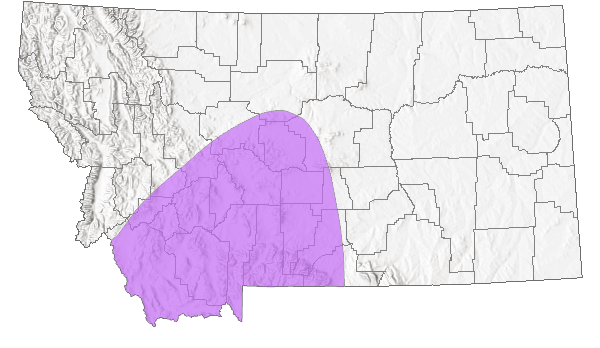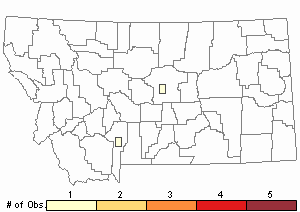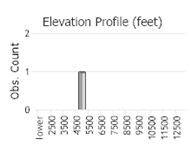View in other NatureServe Network Field Guides
NatureServe
Montana
Utah
Wyoming
Idaho
Wisconsin
British Columbia
South Carolina
Yukon
California
New York
Broad-winged Bush Katydid - Scudderia pistillata
General Description
The following comes from Rehn and Hebard (1914), Blatchley (1920), Hebard (1928), Cantrall (1943), Helfer (1971), Vickery and Kevan (1985), Dethier (1992), Bland (2003), Capinera et al. (2004), Elliott and Hershberger (2007), Himmelman (2009), and Scott (2010). This is a robust, short-bodied and short-legged species with a grass-green body color and pale yellow stripe along the lateral edges of the pronotum (thorax). The tegmina (forewings) are very broad, dull in color and very leaf-like—partially due to the veins being heavier than other
Scudderia species. The forewings are shorter than the hind wings, measuring only three times as long as wide. In the field, their flight is seemingly slow, clumsy, labored and may fly level or slightly undulating. Sometimes they can be collected with the fingers, but they are very difficult to find due to their leaf-like appearance and color mimicry.
Calling song description The Broad-winged Bush Katydid is considered to produce the loudest songs (to the human ear) of all the
Scudderia species. It also sings three distinct songs (some authors recognize four): daytime, dusk and nighttime songs. This species is also often referred to as the “katydid that can count!” Elliott and Hershberger (2007) describe the song counting as “The nocturnal song is a series of about five groups of lispy buzzing notes…The male starts by giving a quick sequence of two or three buzzes. After a long pause, he gives a sequence of five or six buzzes, and so forth until he completes the entire series. The interval between these ‘counting sequences’ is highly variable but is usually a number of seconds. There is also a gradual increase in volume from the beginning of a series to the end. [They] sing a different song during the day—a five-syllabled lispy rattle, given singly or in a series.” Himmelman (2009) describes the calling song as “This species has three distinct calls. One call begins with a lispy, rapid-sequence ‘zick-zick-zick.’ After a pause it adds a slightly louder note or two: ‘zick-zick-zick-ZICK ZICK.’ Then another pause and another couple notes are added, those notes louder yet: ‘zick-zick-zick-zick-zick-ZICK ZICK.’ It will do this a handful of times before starting over. It also gives a series of crackling wet ‘ticks’ and a very short, rapid, buzzy ‘zi-di-dip.’ Calls day and night.” Vickery and Kevan (1985) describe it as “The song is a harsh ‘tsick,’ consisting of 5-8 rapid pulses, increasing in loudness at the end. Intervals between songs vary from 2 minutes to more than 1 hour. Cantrall (1943) reported a frequency of about 20 minutes with favorable weather conditions. Males usually perch on top of vegetation when stridulating.
Imitating Female Sounds Male Bush Katydids,
Scudderia sp., which inhabit dense vegetation or high in thickets and treetops can be attracted for viewing and/or collecting by imitating the female sound. Females of the
Scudderia genera produce a “tick” at species-specific time intervals after certain sounds are made by males. This “tick” attracts a mate-seeking male and can be imitated in a variety of ways. The only requirements are the “tick” contain a high frequency sound and be produced at a specific time after the male call. One can do this by snapping/clicking the fingernails together or striking the tip of a knife blade against a solid object such as the handle of a collecting net or the rounded bottom edge of a small glass bottle or jar. The latter method has proven the most successful by many entomologists. To attract a male, the timing of producing the female imitation is critical. Analyses of mean averages of the timing suggests the following for the three Montana Bush Katydid species:
S. furcata 1.37 sec.,
S. texensis 1.16 sec., and
S. pistillata 0.5-1.0 sec. To practice this method, read Spooner (1968).
Phenology
Overwinters in the egg stage. Adults occur from late-June to late-October, depending upon heavy frost date (Vickery and Kevan 1985, Scott 2010).
Diagnostic Characteristics
The following is taken from Rehn and Hebard (1914), Blatchley (1920), Hebard (1928), Helfer (1971), Vickery and Kevan (1985), Bland (2003), Capinera et al. (2004), Himmelman (2009), and Scott (2010). The body length to end of forewings is 19-20 mm for males and females. The pronotum (thorax) of males and females is 4.7-5.7 mm. The tegmina (forewings) of the male is 29-33 mm long and 9-11 mm wide, and that of the female is 25.5-28 mm long and 8-9 mm wide. The hind femur measures 21-29 mm in males, and 19.5-21 mm in females with an ovipositor of 6.5 mm.
Of the three Montana species of “Bush Katydids,” the Broad-winged is perhaps the easiest to identify, due to its robustness and it’s very broad tegmina as described above. However, it remains important to examine that “fool-proof” character for this species’ which is, the male genitalia at the tip of the abdomen and the dorsal view of the apical is U-shaped or forked notch of the supra-anal plate. It is more shallowly notched than the other two Montana “bush katydids” (refer to illustration above) (Vickery and Kevan 1985, Bland 2003, and Scott 2010).
Species Range
Montana Range
Range Descriptions

 Native
Native
Range Comments
The Broad-winged Bush Katydid is the most northern ranging species of the Scudderia genera, often referred to as a “Boreal species.” It is distributed from Nova Scotia, westward across the southern fourth of the Canadian Provinces to the Alberta-British Columbia border, southward through Montana, northern Wyoming, and angling eastward across the Dakotas, Iowa, to West Virginia and through the New England states. In Montana, it has been reported for 3 counties (Vickery and Kevan 1985, Scott 2010, and Walker SINA website 2020).
Observations in Montana Natural Heritage Program Database
Number of Observations: 3
(Click on the following maps and charts to see full sized version)
Map Help and Descriptions
Relative Density

Recency



 (Observations spanning multiple months or years are excluded from time charts)
(Observations spanning multiple months or years are excluded from time charts)
Habitat
This species prefers damp habitats such as meadows, marshes, and roadside ditches with shrubs and tall forbs. During daytime it hides amid heavy growths of grasses and sedges. At night, individuals climb to the top foliage of shrubs where they sit, move slowly from leaf to leaf, and males sing from time to time (Rehn and Hebard 1914, Cantrall 1943, Vickery and Kevan 1985, and Bland 2003).
Food Habits
To date, no detailed food habits have been found in the literature.
Reproductive Characteristics
There are currently limited, detailed studies in the literature regarding this species’ courtship, nuptial gifts, etc. but its’ reproductive characteristics are probably similar to those presented for
Fork-tailed Bush Katydid (
Scudderia furcata). The Broad-winged Bush Katydid produces one generation per year. Egg deposition by the female is probably also similar to that of
Scudderia furcata (Blatchley 1920, and Vickery and Kevan 1985).
Stewardship Responsibility
References
- Literature Cited AboveLegend:
 View Online Publication
View Online Publication Bland, R.G. 2003. The Orthoptera of Michigan—Biology, Keys, and Descriptions of Grasshoppers, Katydids, and Crickets. East Lansing, MI: Michigan State University Extension, Bulletin E-2815. 221 p.
Bland, R.G. 2003. The Orthoptera of Michigan—Biology, Keys, and Descriptions of Grasshoppers, Katydids, and Crickets. East Lansing, MI: Michigan State University Extension, Bulletin E-2815. 221 p. Blatchley, W. 1920. Orthoptera of Northeastern America, section Phaneropterinae pp. 459-494. In: Nature Publishing, Indianapolis, IN.
Blatchley, W. 1920. Orthoptera of Northeastern America, section Phaneropterinae pp. 459-494. In: Nature Publishing, Indianapolis, IN. Cantrall IJ. 1943. The ecology of the Orthoptera and Dermaptera of the George Reserve, Michigan. Misc. Publications, Museum of Zoology, University of Michigan 54:1-182.
Cantrall IJ. 1943. The ecology of the Orthoptera and Dermaptera of the George Reserve, Michigan. Misc. Publications, Museum of Zoology, University of Michigan 54:1-182. Capinera, J.L., R.D. Scott, and T.J. Walker. 2004. Field Guide to Grasshoppers, Katydids, and Crickets of the United States. Ithaca, NY. Cornell University Press.
Capinera, J.L., R.D. Scott, and T.J. Walker. 2004. Field Guide to Grasshoppers, Katydids, and Crickets of the United States. Ithaca, NY. Cornell University Press. Dethier, V.G. 1992. Crickets and Katydids, Concerts and Solos. Cambridge, MA: Harvard University Press. 140 p.
Dethier, V.G. 1992. Crickets and Katydids, Concerts and Solos. Cambridge, MA: Harvard University Press. 140 p. Elliott, L. and W. Hershberger. 2007. The songs of insects. New York, NY: Houghton Mifflin Harcourt. 227 p.
Elliott, L. and W. Hershberger. 2007. The songs of insects. New York, NY: Houghton Mifflin Harcourt. 227 p. Hebard, M. 1928. The Orthoptera of Montana. Proceedings of the Academy of Natural Sciences of Philadelphia, Vol. 80:211-306.
Hebard, M. 1928. The Orthoptera of Montana. Proceedings of the Academy of Natural Sciences of Philadelphia, Vol. 80:211-306. Helfer, J.R. 1971. How to Know the Grasshoppers, Crickets, Cockroaches, and Their Allies. Revised edition (out of print), Mineola, NY: Dover Publications.
Helfer, J.R. 1971. How to Know the Grasshoppers, Crickets, Cockroaches, and Their Allies. Revised edition (out of print), Mineola, NY: Dover Publications. Himmelman, J. 2009. Guide to Night-Singing Insects of the Northeast. Mechanicsburg, PA: Stackpole Books. 160 p.
Himmelman, J. 2009. Guide to Night-Singing Insects of the Northeast. Mechanicsburg, PA: Stackpole Books. 160 p. Rehn, J.A. and M. Hebard. 1914. Studies in American Tettigoniidae. Transactions of the American Entomological Society x1:271-344.
Rehn, J.A. and M. Hebard. 1914. Studies in American Tettigoniidae. Transactions of the American Entomological Society x1:271-344. Scott, R.D. 2010. Montana Grasshoppers, Katydids, and Crickets A Pictorial Field Guide to the Orthoptera. MagpieMTGraphics, Billings, MT.
Scott, R.D. 2010. Montana Grasshoppers, Katydids, and Crickets A Pictorial Field Guide to the Orthoptera. MagpieMTGraphics, Billings, MT. Spooner, J.D. 1968. Collection of male phaneropterine katydids by imitating sounds of the female. Journal of the Georgia Entomological Society 3(2):45-46.
Spooner, J.D. 1968. Collection of male phaneropterine katydids by imitating sounds of the female. Journal of the Georgia Entomological Society 3(2):45-46. Vickery, V. R. and D. K. M. Kevan. 1985. The grasshopper, crickets, and related insects of Canada and adjacent regions. Biosystematics Research Institute, Ottawa, Ontario. Publication Number 1777. 918 pp.
Vickery, V. R. and D. K. M. Kevan. 1985. The grasshopper, crickets, and related insects of Canada and adjacent regions. Biosystematics Research Institute, Ottawa, Ontario. Publication Number 1777. 918 pp. Walker T.J.(ed.). 2020. Singing insects of North America. Accessed 10 February 2021. https://orthsoc.org/sina/
Walker T.J.(ed.). 2020. Singing insects of North America. Accessed 10 February 2021. https://orthsoc.org/sina/
- Additional ReferencesLegend:
 View Online Publication
View Online Publication
Do you know of a citation we're missing? Fulton, B.B. 1933. Stridulating organs of female Tettigoniidae (Orthoptera). Entomological News XLIV:270-275.
Fulton, B.B. 1933. Stridulating organs of female Tettigoniidae (Orthoptera). Entomological News XLIV:270-275. Gwynne, D.T. 2001. Katydids and Bush-Crickets, Reproductive Behavior and Evolution of the Tettigoniidae. Ithaca, NY: Cornell University Press.
Gwynne, D.T. 2001. Katydids and Bush-Crickets, Reproductive Behavior and Evolution of the Tettigoniidae. Ithaca, NY: Cornell University Press. Himmelman, J. 2011. Cricket radio: tuning in the night-singing insects. Cambridge, MA: The Belknap Press of Harvard University Press. 272 p.
Himmelman, J. 2011. Cricket radio: tuning in the night-singing insects. Cambridge, MA: The Belknap Press of Harvard University Press. 272 p. Villarreal, S.M. and C. Gilbert. 2011. Unique counting call of a katydid, Scudderia pistillata (Orthoptera:Tettigoniidae:Phaneropterinae). Annals of the Entomological Society of America 104(5):945-951.
Villarreal, S.M. and C. Gilbert. 2011. Unique counting call of a katydid, Scudderia pistillata (Orthoptera:Tettigoniidae:Phaneropterinae). Annals of the Entomological Society of America 104(5):945-951.
- Web Search Engines for Articles on "Broad-winged Bush Katydid"
- Additional Sources of Information Related to "Insects"





